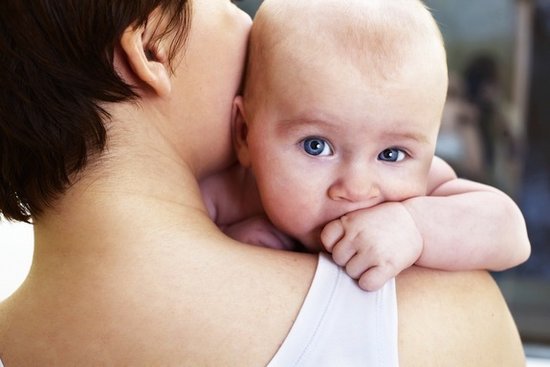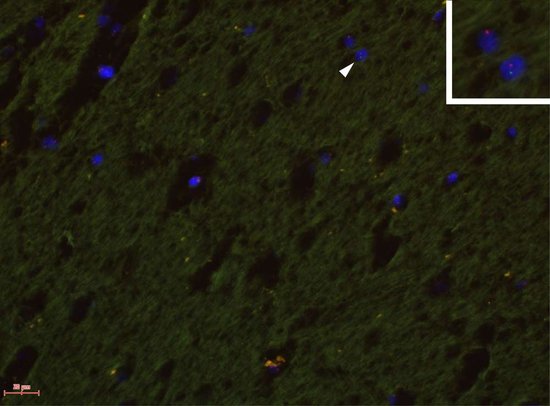本帖最后由 sunsong7 于 2012-10-5 15:30 编辑 # V6 L; d7 v6 `/ h/ M
( O3 @; A2 W% i3 b5 Q1 L5 N4 ^: G( T5 Y2 U$ Y- m
+ q( k' Y" j2 e, R5 \* n
孕妇与胎儿存在细胞交换现象 2012年09月28日07:54腾讯科学
( C8 e9 f( T7 t/ \6 C6 K: \' Q
7 T' M2 d, F3 O$ \; @/ L0 |
; d; {+ Y, K3 a1 t# R+ d/ h[导读]研究结果表明在怀孕期间,母亲和胎儿常常交换细胞,这些细胞似乎能在体内存活数年,这种现象被称为“微嵌合体”。胎儿细胞甚至能够移动到母亲的大脑当中。 腾讯科学讯(过客/编译)一位母亲或许一直都把她的孩子放在心里。研究人员称,最新研究结果发现胎儿的细胞能够移动到他们母亲的大脑中。科学家补充道,尚不确定的是这些细胞是否对母亲有益或者有害,又或者两者兼有。 转播到腾讯微博
4 w, ]5 M0 m) ^9 Z. k9 M 7 f# L! b9 ^2 d" q 7 f# L! b9 ^2 d" q
! t( o4 p/ [2 Y+ p0 q9 Q科学家证实胎儿DNA能够移动到母亲大脑中的研究表明,母亲的心中总是有着她的宝宝 转播到腾讯微博- j) d+ M& A# ?4 P1 t
 ! \0 Z- F/ t* o; p: Q ! \0 Z- F/ t* o; p: Q
8 a) A( {9 U- l; V科学家们第一次在一位母亲的大脑中发现胎儿细胞(如图所示) 最近的研究结果表明在怀孕期间,母亲和胎儿常常交换细胞,这些细胞似乎能在体内存活数年,这种现象被称为“微嵌合体”。科学家已经在老鼠中发现了那种现象,胎儿细胞甚至能够移动到母亲的大脑当中。这也是研究人员第一次有证据证实人类胎儿细胞的这种状况。 研究人员分析了59位女性的大脑,她们去世的年龄从32岁到101岁不等。他们寻找男性DNA的迹象,他们推断这些男性DNA来自于她们的儿子。(之所以寻找男性DNA是因为女性DNA难以与母亲的基因区分开。)接近2/3的女性(59名女性中的37人)被发现在她们的大脑中的多个区域存在男性Y染色体。这一现象很显然持续了很长时间:拥有男性胎儿DNA的女性中年龄最大的是94岁。 一种名为血脑屏障的防御体系阻止了血液中的许多药物和细菌进入大脑。然而医生已经发现这种屏障在怀孕期间变得更具可渗透性,这就能解释这些胎儿细胞如何移动到他们母亲的大脑当中。 尽管26名女性生前没有大脑混乱的迹象,其它的33名女性患有老年痴呆症。研究人员发现患有老年痴呆的女性大脑中含有男性DNA的可能性低于比未患病的女性。西雅图弗雷德哈钦森癌症研究中心的一位免疫系统学家威廉告诉《生命科学》道:“我们的研究发现最重要的含义是微嵌合体对于大脑中的许多不同疾病可能产生的正面和负面的影响,比如说变性疾病和癌症等。” 之前对于微嵌合体的研究表明胎儿细胞或许能帮助母亲对抗乳腺癌和进行组织修复,但是也能够增加直肠癌的风险以及刺激免疫系统疾病,这样就会导致一个人的身体被自身的免疫系统所错误的攻击。未来的研究或许想要检查大脑中的胎儿细胞是否在老年痴呆症中扮演一个角色。过去的研究表明老年痴呆在多子女的女性中比无子女的女性更加普遍。 威廉说到:“现在我们还不清楚大脑中的微嵌合体对于健康是有益还是有害。我们认为很可能微嵌合体在某些方面带来益处,但是在其它的方面或许会带来一个疾病过程。这还需要进一步的研究。” 最新研究的局限性之一就是参与研究的大脑数量相对较少。威廉说到:“除此之外,我们不能够获得大多数女性的怀孕历史信息,因此目前不可能把我们的发现解释为对于老年痴呆症是积极的或者消极的。这项研究也并未确定微嵌合体细胞的细胞种类,这是我们在未来研究中希望能解决的课题。”哈钦森癌症研究中心的一位医生尼尔森告诉《生命科学》,研究人员们也想要了解一位母亲的细胞对于她后代的发育和健康产生什么样的影响。
4 |' y, v$ v1 N1 G. V
+ _5 o& ^$ i1 D$ \1 D3 ~2 p7 p( B# p& T4 U7 w$ A5 D! L$ y; r, Y
7 b' d( b" E o% ]$ E
Your Cells Are My Cells [Preview]Many, perhaps all, people harbor a small number of cells from genetically different individuals--from their mothers and, for women who have been pregnant, from their children. What in the world do these foreigners do in the body? ByJ. Lee Nelson / j+ T- n7 q2 B! o: ]: @( G7 f
 The Mother-Baby BondAfter spending nine months intricately joined together, mother and infant share more than just common features. Now, in a special partnership with theVisualMD.com , we present a look at this remarkable bond, complete with scientifically accurate and stunning images. »April 30, 20106 X {7 V% }' O1 u: q* h/ F The Mother-Baby BondAfter spending nine months intricately joined together, mother and infant share more than just common features. Now, in a special partnership with theVisualMD.com , we present a look at this remarkable bond, complete with scientifically accurate and stunning images. »April 30, 20106 X {7 V% }' O1 u: q* h/ F
Two-Way Transport: During pregnancy, some cells travel from mother to baby and some go from baby to mother. A fraction may persist in their new host. The condition is termed microchimerism.Image: Bryan Christie Design In Brief- Recent research suggests that each of us harbors some cells that originated in other, genetically distinct individuals - a condition called microchimerism. All of us probably save cells we have acquired from our mother during gestation, and women who have been pregnant retain cells that come from the fetus.
- The acquired cells can persist for decades and may establish residence inside tissues, becoming an integral part of the body's organs.
- Microchimerism could contribute to an immune attack in some cases but help the body heal in others. These effects make the acquired cells intriguing new targets for therapeutics that could curb auto immunity or promote regeneration of damaged tissues.
0 S% k4 h3 C2 q* S
( r( |+ |! ?/ c1 L! ~5 F
f$ v' ~" G4 e' a7 s! @
"I contain multitudes," says a line in Walt Whitman's poem "Song of Myself." Whitman was not thinking in biological terms, but the line has biological resonance. Recent studies suggest that each of us possesses in addition to the trillions of cells descended from the fertilized eggs we once were - a cadre of cells we have acquired from other, genetically distinct individuals. In utero we receive an infusion of them from mom. And women who become pregnant also collect a sampling shed by the developing embryo.4 ^2 |$ J# {9 x5 b' Z8 Q
, G; N' b# }' R- `9 [
That cells cross the placenta is not surprising. After all, the tissue that connects mother and child is not an impenetrable barricade. It is more like a selective border crossing, allowing passage, for instance, of materials needed for the fetus' development. What is remarkable, however, is the extent to which migrant cells can persist in their new host, circulating in the blood and even taking up residence in various tissues. The intermingling of some cells from one person inside the body of another - a phenomenon termed microchimerism - is now drawing intense scrutiny from medical researchers, because recent work suggests it may contribute to both health and disease. Better understanding of the actions of the transferred cells could someday allow clinicians to harness the stowaways' beneficial effects while limiting their destructive potential.
/ r8 E& A' }$ N, l1 k! X) |" K8 R( X: e2 R' |( ~- w. r% g9 N2 s
3 A6 v" U9 q. G% y# d, i
9 t% l u& C; U$ c4 S |